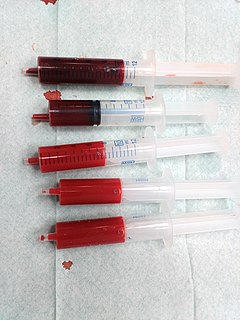 W
WBlood is a body fluid in humans and other animals that delivers necessary substances such as nutrients and oxygen to the cells and transports metabolic waste products away from those same cells.
 W
WAdrenal hemorrhage (AH) describes an acute blood loss from a ruptured blood vessel connecting to adrenal glands above kidneys.
 W
WAutohaemorrhaging, or reflex bleeding, is the action of animals deliberately ejecting blood from their bodies. Autohaemorrhaging has been observed as occurring in two variations. In the first form, blood is squirted toward a predator. The blood of these animals usually contains toxic compounds, making the behaviour an effective chemical defence mechanism. In the second form, blood is not squirted, but is slowly emitted from the animal's body. This form appears to serve a deterrent effect, and is used by animals whose blood does not seem to be toxic. Most animals that autohaemorrhage are insects, but some reptiles also display this behaviour.
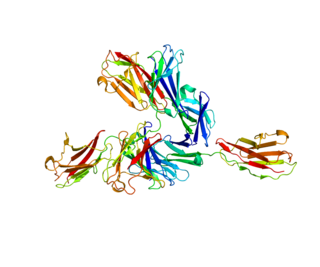 W
WBasigin (BSG) also known as extracellular matrix metalloproteinase inducer (EMMPRIN) or cluster of differentiation 147 (CD147) is a protein that in humans is encoded by the BSG gene. This protein is a determinant for the Ok blood group system. There are three known antigens in the Ok system; the most common being Oka, OK2 and OK3. Basigin has been shown to be an essential receptor on red blood cells for the human malaria parasite, Plasmodium falciparum.
 W
WBlood brother can refer to one of two things: a male related by birth, or two or more men not related by birth who have sworn loyalty to each other. This is in modern times usually done in a ceremony, known as a blood oath, where each person makes a small cut, usually on a finger, hand or the forearm, and then the two cuts are pressed together and bound, the idea being that each person's blood now flows in the other participant's veins. The act may carry a risk due to blood-borne diseases. The process usually provides a participant with a heightened symbolic sense of attachment with another participant.
 W
WBlood compact was an ancient ritual in the Philippines intended to seal a friendship or treaty, or to validate an agreement. The contracting parties would cut their wrists and pour their blood into a cup filled with liquid, such as wine, and drink the mixture.
 W
WBlood fractionation is the process of fractionating whole blood, or separating it into its component parts. This is typically done by centrifuging the blood.
 W
WBlood of Christ in Christian theology refers to (a) the physical blood actually shed by Jesus Christ primarily on the Cross, and the salvation which Christianity teaches was accomplished thereby; or (b) the sacramental blood present in the Eucharist or Lord's Supper, which some Christian denominations believe to be the same blood of Christ shed on the Cross.
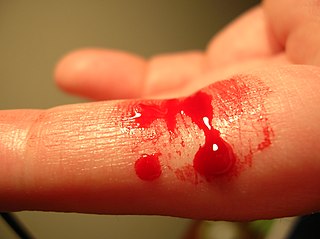 W
WBlood phobia is an extreme irrational fear of blood, a type of specific phobia. Severe cases of this fear can cause physical reactions that are uncommon in most other fears, specifically vasovagal syncope (fainting). Similar reactions can also occur with trypanophobia and traumatophobia. For this reason, these phobias are categorized as "blood-injection-injury phobia" by the DSM-IV. Some early texts refer to this category as "blood-injury-illness phobia."
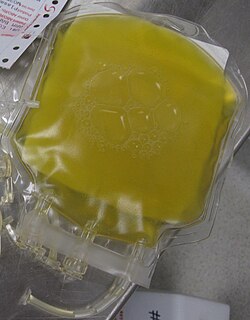 W
WBlood plasma is a yellowish liquid component of blood that holds the blood cells of whole blood in suspension. It is the liquid part of the blood that carries cells and proteins throughout the body. It makes up about 55% of the body's total blood volume. It is the intravascular fluid part of extracellular fluid (all body fluid outside cells). It is mostly water (up to 95% by volume), and contains important dissolved proteins (6–8%) (e.g., serum albumins, globulins, and fibrinogen), glucose, clotting factors, electrolytes (Na+, Ca2+, Mg2+, HCO3−, Cl−, etc.), hormones, carbon dioxide (plasma being the main medium for excretory product transportation), and oxygen. It plays a vital role in an intravascular osmotic effect that keeps electrolyte concentration balanced and protects the body from infection and other blood disorders.
 W
WThe "Blood Qur'an" is a copy of the Islamic holy book, the Qur'an, claimed to have been written in the blood of the former president of Iraq, Saddam Hussein, over the course of two years in the late 1990s. Saddam commissioned the book in 1997 on his 60th birthday, reportedly to give thanks to God for helping him through many "conspiracies and dangers". He explained his reasons for commissioning the book in a letter published by the Iraqi state media in September 2000: "My life has been full of dangers in which I should have lost a lot of blood ... but since I have bled only a little, I asked somebody to write God's words with my blood in gratitude." Saddam's act was denounced in 2000 by the religious authorities of the United Arab Emirates and Saudi Arabia, and, after his fall from power in 2003, the Qur'an was removed from public display. Controversy persists over how much blood Saddam contributed to the project, or whether any of it is even his at all. The fate of the book also presented heavy controversies, since for islamic laws writing the Qur'an in blood is considered a blasphemous heresy, but so would be destroying the Qur'an even if to cleanse such a blasphemy.
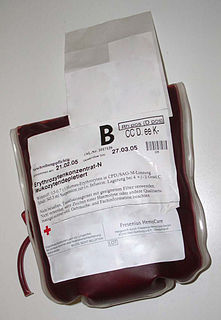 W
WBlood transfusion is the process of transferring blood or blood products into one's circulation intravenously. Transfusions are used for various medical conditions to replace lost components of the blood. Early transfusions used whole blood, but modern medical practice commonly uses only components of the blood, such as red blood cells, white blood cells, plasma, clotting factors, and platelets.
 W
WBlood-spinning is a medical procedure used to shorten the healing time of an injury. Small samples of the patient's blood are taken and spun in a centrifuge, allowing platelets and blood plasma to be isolated from other blood components. The platelets and plasma are then combined forming platelet-rich plasma (PRP), which has high concentrations of natural growth factors. The PRP sample can then be injected into the patient's injury, which may help reduce pain and improve recovery speeds.
 W
WBloodletting is the withdrawal of blood from a patient to prevent or cure illness and disease. Bloodletting, whether by a physician or by leeches, was based on an ancient system of medicine in which blood and other bodily fluids were regarded as "humours" that had to remain in proper balance to maintain health. It is claimed to have been the most common medical practice performed by surgeons from antiquity until the late 19th century, a span of over 2,000 years. In Europe the practice continued to be relatively common until the end of the 18th century. The practice has now been abandoned by modern-style medicine for all except a few very specific medical conditions. It is conceivable that historically, in the absence of other treatments for hypertension, bloodletting sometimes had a beneficial effect in temporarily reducing blood pressure by reducing blood volume. However, since hypertension is very often asymptomatic and thus undiagnosable without modern methods, this effect was unintentional. In the overwhelming majority of cases, the historical use of bloodletting was harmful to patients.
 W
WBloodstain Pattern Analysis (BPA) is the study and analysis of bloodstains at a known or suspected crime scene with the purpose of drawing conclusions about the nature, timing and other details of the crime. It is one of the several specialties of forensic science.
 W
WThe buffy coat is the fraction of an anticoagulated blood sample that contains most of the white blood cells and platelets following density gradient centrifugation.
 W
WThe Centre for Blood Research (CBR) is a multidisciplinary biomedical research institute, situated primarily at the University of British Columbia (UBC) and affiliated teaching hospitals in Vancouver, British Columbia, Canada, with nodes at the University of Northern British Columbia and at the University of Victoria. Its mission is to improve the health and well-being of patients by performing innovative research in blood and blood-related processes.
 W
WCoagulation, also known as clotting, is the process by which blood changes from a liquid to a gel, forming a blood clot. It potentially results in hemostasis, the cessation of blood loss from a damaged vessel, followed by repair. The mechanism of coagulation involves activation, adhesion and aggregation of platelets, as well as deposition and maturation of fibrin.
 W
WIn the contact activation system or CAS, three proteins in the blood, factor XII (FXII), prekallikrein (PK) and high molecular weight kininogen (HK), bind to a surface and cause blood coagulation and inflammation. FXII and PK are proteases and HK is a non-enzymatic co-factor. The CAS can activate the kinin–kallikrein system and blood coagulation through its ability to activate multiple downstream proteins. The CAS is initiated when FXII binds to a surface and reciprocal activation of FXII and PK occurs, forming FXIIa and PKa. FXIIa can initiate the coagulation cascade by cleaving and activating factor XI (FXI), which leads to formation of a blood clot. Additionally, the CAS can activate the kinin–kallikrein system when PKa cleaves HK to form cHK, releasing a peptide known as bradykinin (BK). BK and its derivatives bind to bradykinin receptors B1 and B2 to mediate inflammation.
 W
WComplement decay-accelerating factor, also known as CD55 or DAF, is a protein that, in humans, is encoded by the CD55 gene.
 W
WFibrin glue is a surgical formulation used to create a fibrin clot for hemostasis or wound healing. It contains separately packaged human fibrinogen and human thrombin.
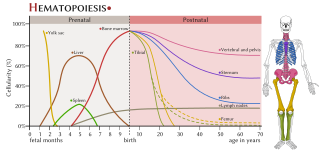 W
WThe haematopoietic system is the system in the body involved in the creation of the cells of blood.
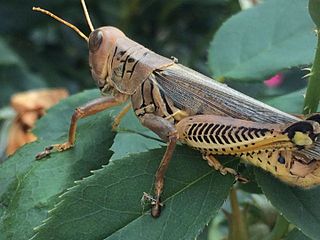 W
WHemolymph, or haemolymph, is a fluid, analogous to the blood in vertebrates, that circulates in the interior of the arthropod body remaining in direct contact with the animal's tissues. It is composed of a fluid plasma in which hemolymph cells called hemocytes are suspended. In addition to hemocytes, the plasma also contains many chemicals. It is the major tissue type of the open circulatory system characteristic of arthropods. In addition, some non-arthropods such as molluscs possess a hemolymphatic circulatory system.
 W
WHemolysis is the breakdown of red blood cells. The ability of bacterial colonies to induce hemolysis when grown on blood agar is used to classify certain microorganisms. This is particularly useful in classifying streptococcal species. A substance that causes hemolysis is a hemolysin.
 W
WHypoxia preconditioned plasma or hypoxia pre-conditioned plasma (abbreviated as HPP) is the (cell-free) plasma obtained after extracorporeal conditioning (i.e. culturing) of anticoagulated blood under physiological temperature (37 °C) and physiological hypoxia (1–5 %O2). Blood conditioning is typically carried out over 2 to 4 days.
 W
WThe IBM 2991 Blood Cell Processor was a blood cell washer developed by IBM Systems Development Division in Endicott, NY. It was first marketed by IBM Systems Supplies Division (SSD) in 1972. The processor washed fresh blood or frozen, thawed blood. In the case of frozen, thawed blood, the blood was washed to remove the cryogenic agent, typically, glycerol.
 W
WImpurity after childbirth is a form of impurity, primarily found in Abrahamic religions, that begins after a woman has given birth. It is connected to the seclusion imposed by the expectations of postpartum confinement.
 W
WThe Legend of the Four Blood Bars is a legend about the origins of the Senyera Reial that appeared for the first time in 1551 at Segunda parte de la crónica general de España, a chronicle edited by Pere Antoni Beuter in Spanish in Valencia. This legend places the Senyera Reial origins on Wilfred the Hairy. Specifically, it narrates that the sign of the four bars was created after a battle against the Normans, when the King of the Franks doused his hands in the blood of Wilfred the Hairy's injuries. After swiping his fingers over the golden shield of the Earl of Barcelona he said: "These will be your arms, Earl".
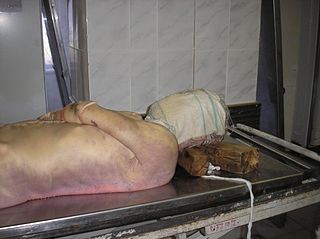 W
WLivor mortis, postmortem lividity, hypostasis or suggillation, is the fourth stage of death and one of the signs of death. It is a settling of the blood in the lower, or dependent, portion of the body postmortem, causing a purplish red discoloration of the skin. When the heart stops functioning and is no longer agitating the blood, heavy red blood cells sink through the serum by action of gravity. The blood travels faster in warmer conditions and slower in colder conditions.
 W
WIn biology, a lumen is the inside space of a tubular structure, such as an artery or intestine. It comes from Latin lumen 'an opening'.
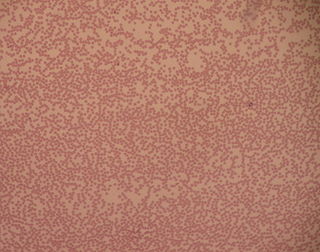 W
WNeutropenia is an abnormally low concentration of neutrophils in the blood. Neutrophils make up the majority of circulating white blood cells and serve as the primary defense against infections by destroying bacteria, bacterial fragments and immunoglobulin-bound viruses in the blood. People with neutropenia are more susceptible to bacterial infections and, without prompt medical attention, the condition may become life-threatening.
 W
WOxygen saturation is a relative measure of the concentration of oxygen that is dissolved or carried in a given medium as a proportion of the maximal concentration that can be dissolved in that medium. It can be measured with a dissolved oxygen probe such as an oxygen sensor or an optode in liquid media, usually water. The standard unit of oxygen saturation is percent (%).
 W
WOxygen saturation is the fraction of oxygen-saturated hemoglobin relative to total hemoglobin in the blood. The human body requires and regulates a very precise and specific balance of oxygen in the blood. Normal arterial blood oxygen saturation levels in humans are 95–100 percent. If the level is below 90 percent, it is considered low and called hypoxemia. Arterial blood oxygen levels below 80 percent may compromise organ function, such as the brain and heart, and should be promptly addressed. Continued low oxygen levels may lead to respiratory or cardiac arrest. Oxygen therapy may be used to assist in raising blood oxygen levels. Oxygenation occurs when oxygen molecules enter the tissues of the body. For example, blood is oxygenated in the lungs, where oxygen molecules travel from the air and into the blood. Oxygenation is commonly used to refer to medical oxygen saturation.
 W
WSerum is the fluid and solute component of blood which does not play a role in clotting. It may be defined as blood plasma without fibrinogens. Serum includes all proteins not used in blood clotting; all electrolytes, antibodies, antigens, hormones; and any exogenous substances. Serum does not contain white blood cells (leukocytes), red blood cells (erythrocytes), platelets, or clotting factors.
 W
WBlood in stool looks different depending on how early it enters the digestive tract—and thus how much digestive action it has been exposed to—and how much there is. The term can refer either to melena, with a black appearance, typically originating from upper gastrointestinal bleeding; or to hematochezia, with a red color, typically originating from lower gastrointestinal bleeding. Evaluation of the blood found in stool depends on its characteristics, in terms of color, quantity and other features, which can point to its source, however, more serious conditions can present with a mixed picture, or with the form of bleeding that is found in another section of the tract. The term "blood in stool" is usually only used to describe visible blood, and not fecal occult blood, which is found only after physical examination and chemical laboratory testing.
 W
WTheatrical blood, stage blood or fake blood is anything used as a substitute for blood in a theatrical or cinematic performance. For example, in the special effects industry, when a director needs to simulate an actor being shot or cut, a wide variety of chemicals and natural products can be used. The most common is red food coloring, often inside small balloons coupled with explosive devices called squibs. However, Alfred Hitchcock used Bosco Chocolate Syrup as fake blood in his 1960 thriller Psycho. Since the film was in black and white, the color was less important than the consistency. Tomato ketchup is also a common alternative.
 W
WThrombosis prevention or thromboprophylaxis is medical treatment to prevent the development of thrombosis in those considered at risk for developing thrombosis. Some people are at a higher risk for the formation of blood clots than others. Prevention measures or interventions are usually begun after surgery as people are at higher risk due to immobility.
 W
WA blood type is a classification of blood, based on the presence and absence of antibodies and inherited antigenic substances on the surface of red blood cells (RBCs). These antigens may be proteins, carbohydrates, glycoproteins, or glycolipids, depending on the blood group system. Some of these antigens are also present on the surface of other types of cells of various tissues. Several of these red blood cell surface antigens can stem from one allele and collectively form a blood group system.
 W
WA vacutainer blood collection tube is a sterile glass or plastic test tube with a colored rubber stopper creating a vacuum seal inside of the tube, facilitating the drawing of a predetermined volume of liquid. Vacutainer tubes may contain additives designed to stabilize and preserve the specimen prior to analytical testing. Tubes are available with a safety-engineered stopper, with a variety of labeling options and draw volumes. The color of the top indicates the additives in the vial.
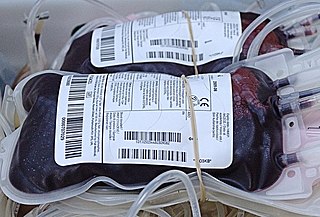 W
WVenous blood is deoxygenated blood which travels from the peripheral blood vessels, through the venous system into the right atrium of the heart. Deoxygenated blood is then pumped by the right ventricle to the lungs via the pulmonary artery which is divided in two branches, left and right to the left and right lungs respectively. Blood is oxygenated in the lungs and returns to the left atrium through the pulmonary veins.
 W
WWhite blood cells (WBCs), also called leukocytes or leucocytes, are the cells of the immune system that are involved in protecting the body against both infectious disease and foreign invaders. All white blood cells are produced and derived from multipotent cells in the bone marrow known as hematopoietic stem cells. Leukocytes are found throughout the body, including the blood and lymphatic system.